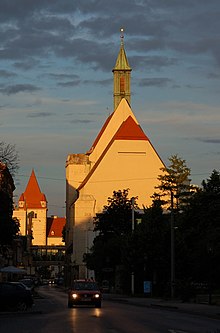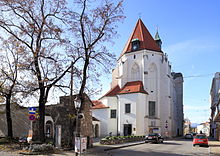Capuchin Church (Wiener Neustadt)
The Capuchin Church of St. Jacob is a Roman Catholic high Gothic Minorite church and later Baroque-style monastery church of the Capuchins in Wiener Neustadt at Bahngasse 23. The church is followed by an early Baroque Capuchin monastery with a monastery garden.
history
Before 1250, a Franciscan monastery ( fratres minores , Friars Minor or Minorites) was founded within the city walls in the south-west corner of Wiener Neustadt. The Minorite Church is mentioned in a document as an indulgence for church visitors in 1267. The existing long choir was built around 1330. The monastery went under during the Reformation . In 1623 the ruins were handed over to the Capuchins, who began to renovate the monastery. The north tower of the church was partially destroyed in the town fire in 1625. Altars were consecrated in 1628 and 1629.
Monastery Church of St. Jacob
Parts of the medieval building of the Friars Minor were supplemented with components around 1330, and a roof turret was added to the west. A late Gothic north tower was added around 1483.
The long choir was redesigned from 1623 to 1628 into an early baroque hall and reoriented to the west with a straight, closed chancel. The Gothic ruin was partly bricked up, partly capped at the top. A barrel vault with stitch caps was set halfway up the former Gothic interior. Above the baroque barrel vault, the Gothic architecture with vaulted vaults, shield ribs, rib approaches and bricked-up tracery windows has been preserved, the Gothic vault is missing.
In the former Gothic end of the choir on the south side there is a three-arched cross-ribbed seating niche with heads on flower capping stones and a tracery on the back wall. An unadorned hexagonal anteroom was added by the Capuchins to the east in the 17th century. Only indeterminate fragments of the Gothic wall painting have survived.
On the high altar wall is a crucifixion group from the 18th century. In a niche is a former altarpiece Francis , in the south-facing chapel the altar bears the altarpiece Felix von Cantalice with the Christ child and Mary , both by Anton Wagenschön from the 18th century.
The altar of grace in the Konrad chapel, consecrated in 1747, bears a reliquary glass sarcophagus of St. Brother Konrad. Above it are Gothic statues of Mary with the Child and James the Elder by the Wiener Neustädter Minoritenmeister around 1330. In the Konrad Chapel there is a votive picture of St. Florian with the view of the burning city of Wiener Neustadt by the painter G. A. Waßhuber, which depicts the fire of 1699.
In the almost square, square vaulted Trinity Chapel, there is an altarpiece Trinity by father and painter Dariusz Kochanski from 2000. Above the Trinity Chapel is a square room with a late Gothic ribbed vault from the 15th century, formerly a nave vault of the Minorite Church, which was also used in the 17th century a staircase and doors and shelves to the monastery library was expanded.
There is a baroque baptismal font with a shell basin and balusters from the 17th century. The organ is from 1905.
A nine-axis arcade with square vaults between belt arches runs along Bahngasse to the east of the church and is called the Passage . The associated statues and groups of statues, created around 1700, from the passion of Christ, such as the carrying of the cross, ecce homo, mount of olives, farewell to Mary, Christ on the pillar of torture, crowning of thorns, are currently deposited.
literature
- Dehio manual. The art monuments of Austria: Lower Austria south of the Danube. Part 2. M to Z. Wiener Neustadt. Capuchin monastery with monastery church. Bundesdenkmalamt (Ed.), Berger Verlag, Horn / Vienna 2003, ISBN 3-85028-365-8 , pages 2628ff.
Web links
- Sub-community of the cathedral parish and provost parish Wiener Neustadt on the website of the Archdiocese of Vienna
- Website of the Capuchin Monastery Wiener Neustadt
Coordinates: 47 ° 48 ′ 39.3 " N , 16 ° 14 ′ 23.7" E

